Jeep Cherokee (XJ): Removal and installation
REMOVAL (1) Disconnect negative battery cable at battery.
(2) Disconnect vacuum line at servo (Fig. 1).
(3) Disconnect electrical connector at servo.
(4) Disconnect servo cable at throttle body. Refer to
Servo Cable Removal/Installation.
(5) Remove 2 mounting nuts holding servo cable
sleeve to bracket (Fig. 2).
(6) Pull speed control cable sleeve and servo away
from servo mounting bracket to expose cable retaining
clip (Fig. 2) and remove clip. Note: The servo
mounting bracket displayed in (Fig. 2) is a typical
bracket and may/may not be applicable to this model
vehicle.
1 - R. F. FENDER (7) Remove servo from mounting bracket. While
removing, note orientation of servo to bracket.
1 - SERVO MOUNTING NUTS (2) INSTALLATION (1) Position servo to mounting bracket.
(2) Align hole in cable connector with hole in servo
pin. Install cable-to-servo retaining clip.
(3) Insert servo mounting studs through holes in
servo mounting bracket.
(4) Install servo mounting nuts and tighten to 8.5
N·m (75 in. lbs.).
(5) Connect vacuum line at servo.
(6) Connect electrical connector at servo.
(7) Connect servo cable to throttle body. Refer to
Servo Cable Removal/Installation.
(8) Connect negative battery cable to battery.
(9) Before starting engine, operate accelerator
pedal to check for any binding. WARNING: BEFORE ATTEMPTING TO DIAGNOSE,
REMOVE OR INSTALL ANY AIRBAG SYSTEM OR
RELATED STEERING WHEEL AND STEERING COLUMN
COMPONENTS YOU MUST FIRST DISCONNECT
AND ISOLATE THE BATTERY NEGATIVE
(GROUND) CABLE. WAIT 2 MINUTES FOR SYSTEM
CAPACITOR TO DISCHARGE BEFORE FURTHER
SYSTEM SERVICE. FAILURE TO DO SO COULD
RESULT IN ACCIDENTAL DEPLOYMENT AND POSSIBLE
PERSONAL INJURY. REMOVAL (1) Disconnect and isolate negative battery cable
from battery.
(2) Remove airbag module. Refer to Group 8M,
Passive Restraint Systems.
(3) From underside of steering wheel, remove
speed control switch mounting screw (Fig. 3).
1 - MOUNTING SCREW (4) Remove switch from steering wheel and unplug
electrical connector. INSTALLATION (1) Plug electrical connector into switch.
(2) Position switch to steering wheel.
(3) Install switch mounting screw and tighten to
1.5 N·m (14 in. lbs.) torque.
(4) Install airbag module. Refer to Group 8M, Passive
Restraint Systems.
(5) Connect negative battery cable to battery. REMOVAL (1) Disconnect negative battery cable at battery.
(2) Using finger pressure only, remove cable connector
by pushing connector off the throttle body
bellcrank pin (Fig. 4). DO NOT try to pull cable
connector off perpendicular to the bellcrank
pin. Connector will be broken.
(3) Two release tabs are located on sides of speed
control cable at cable bracket (Fig. 4). Squeeze tabs
together and push cable out of bracket.
(4) Unclip cable from cable guide at valve cover. (5) Disconnect servo cable at servo. Refer to Speed
Control Servo Removal/Installation.
1 - ACCELERATOR CABLE INSTALLATION (1) Attach end of cable to speed control servo.
Refer to Speed Control Servo Removal/Installation.
(2) Install cable into cable bracket (snaps in).
(3) Install cable connector at throttle body
bellcrank pin (snaps on).
(4) Clip cable to cable guide at valve cover.
(5) Connect negative battery cable to battery.
(6) Before starting engine, operate accelerator
pedal to check for any binding. REMOVAL The vacuum reservoir is located behind right front
bumper end cap on vehicles equipped with LHD (Left
Hand Drive) (Fig. 5). It is located behind left front
bumper end cap on vehicles equipped with RHD
(Right Hand Drive).
(1) Remove front bumper end cap. Refer to Front
Bumper End Cap Removal/Installation.
(2) Remove vacuum line at reservoir (Fig. 6). (3) Remove 2 reservoir mounting screws.
(4) Remove reservoir from bumper bar.
1 - BUMPER END CAP INSTALLATION (1) Position reservoir to bumper bar and install
mounting screws. Tighten screws to 8 N·m (72 in.
lbs.) torque.
(2) Install vacuum line to reservoir
(3) Install front bumper end cap. Refer to Front
Bumper End Cap Removal/Installation.
1 - VACUUM LINESpeed control servo
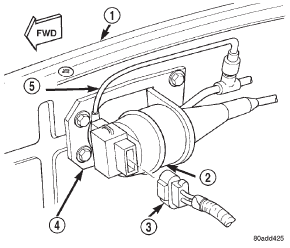
Fig. 1 Speed Control Servo Location
2 - SPEED CONTROL SERVO
3 - ELECTRICAL CONNECTOR
4 - MOUNTING BRACKET
5 - VACUUM LINE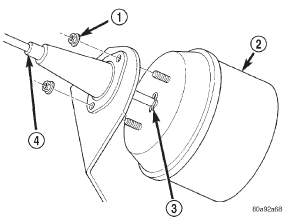
Fig. 2 Servo Cable Clip Remove/Install-Typical
2 - SERVO
3 - CABLE RETAINING CLIP
4 - SERVO CABLE AND SLEESpeed control switch
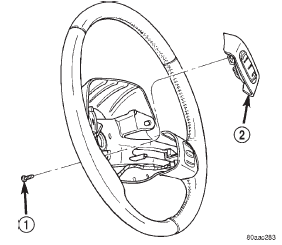
Fig. 3 Speed Control Switch Remove/Install
2 - SPEED CONTROL SWITCHServo cable
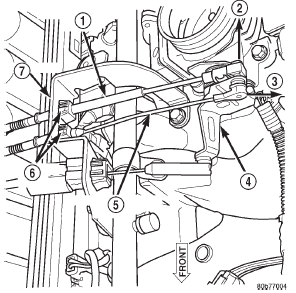
Fig. 4 Speed Control Servo Cable at Throttle Body
2 - OFF
3 - OFF
4 - THROTTLE BODY BELLCRANK
5 - SPEED CONTROL CABLE
6 - RELEASE TABS
7 - BRACKETVacuum reservoir
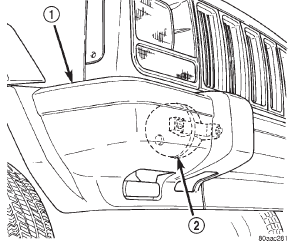
Fig. 5 Vacuum Reservoir Location
2 - VACUUM RESERVOIR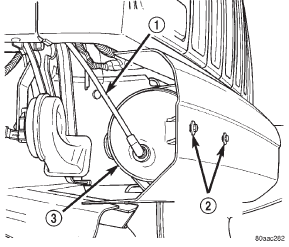
Fig. 6 Vacuum Reservoir Removal/Installation
2 - RESERVOIR SCREWS
3 - VACUUM RESERVOIR
Other materials:
Adjustments
CLOCKSPRING CENTERING
The clockspring is designed to wind and unwind
when the steering wheel is rotated, but is only
designed to rotate the same number of turns (about
five complete rotations) as the steering wheel can be
turned from stop to stop. Centering the clockspring
indexes the clockspr ...


